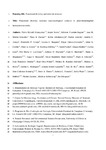Functional diversity mediates macroecological variation in plant–hummingbird interaction networks
| dc.contributor.author | Maruyama, PK | |
| dc.contributor.author | Sonne, J | |
| dc.contributor.author | Vizentin-Bugoni, J | |
| dc.contributor.author | Martín González, AM | |
| dc.contributor.author | Zanata, TB | |
| dc.contributor.author | Abrahamczyk, S | |
| dc.contributor.author | Alarcón, R | |
| dc.contributor.author | Araujo, AC | |
| dc.contributor.author | Araújo, FP | |
| dc.contributor.author | Baquero, AC | |
| dc.contributor.author | Chávez-González, E | |
| dc.contributor.author | Coelho, AG | |
| dc.contributor.author | Cotton, Peter | |
| dc.contributor.author | Dehling, DM | |
| dc.contributor.author | Fischer, E | |
| dc.contributor.author | Kohler, G | |
| dc.contributor.author | Lara, C | |
| dc.contributor.author | Las-Casas, FMG | |
| dc.contributor.author | Machado, AO | |
| dc.contributor.author | Machado, CG | |
| dc.contributor.author | Maglianesi, MA | |
| dc.contributor.author | Malucelli, TS | |
| dc.contributor.author | Marín-Gómez, OH | |
| dc.contributor.author | Oliveira, PE | |
| dc.contributor.author | Ornelas, JF | |
| dc.contributor.author | Ortiz-Pulido, R | |
| dc.contributor.author | Ramírez-Burbano, MB | |
| dc.contributor.author | Rocca, MA | |
| dc.contributor.author | Rodrigues, LC | |
| dc.contributor.author | Rosero-Lasprilla, L | |
| dc.contributor.author | Rui, AM | |
| dc.contributor.author | Sandel, B | |
| dc.contributor.author | Svenning, JC | |
| dc.contributor.author | Tinoco, BA | |
| dc.contributor.author | Varassin, IG | |
| dc.contributor.author | Watts, S | |
| dc.contributor.author | Rahbek, C | |
| dc.contributor.author | Sazima, M | |
| dc.contributor.author | Schleuning, M | |
| dc.contributor.author | Dalsgaard, B | |
| dc.date.accessioned | 2018-10-24T08:12:52Z | |
| dc.date.available | 2018-10-24T08:12:52Z | |
| dc.date.issued | 2018-10 | |
| dc.identifier.issn | 1466-822X | |
| dc.identifier.issn | 1466-8238 | |
| dc.identifier.uri | http://hdl.handle.net/10026.1/12598 | |
| dc.description.abstract |
© 2018 John Wiley & Sons Ltd Aim: Species interaction networks are known to vary in structure over large spatial scales. We investigated the hypothesis that environmental factors affect interaction network structure by influencing the functional diversity of ecological communities. Notably, we expect more functionally diverse communities to form interaction networks with a higher degree of niche partitioning. Location: Americas. Time period: Current. Major taxa studied: Hummingbirds and their nectar plants. Methods: We used a large dataset comprising 74 quantitative plant–hummingbird interaction networks distributed across the Americas, along with morphological trait data for 158 hummingbird species. First, we used a model selection approach to evaluate associations between the environment (climate, topography and insularity), species richness and hummingbird functional diversity as predictors of network structure (niche partitioning, i.e., complementary specialization and modularity). Second, we used structural equation models (SEMs) to ask whether environmental predictors and species richness affect network structure directly and/or indirectly through their influence on hummingbird functional diversity. For a subset of 28 networks, we additionally evaluated whether plant functional diversity was associated with hummingbird functional diversity and network structure. Results: Precipitation, insularity and plant richness, together with hummingbird functional diversity (specifically, functional dispersion), were consistently strong predictors of niche partitioning in plant–hummingbird networks. Moreover, SEMs showed that environmental predictors and plant richness affected network structure both directly and indirectly through their effects on hummingbird functional diversity. Plant functional diversity, however, was unrelated to hummingbird functional diversity and network structure. Main conclusions: We reveal the importance of hummingbird functional diversity for niche partitioning in plant–hummingbird interaction networks. The lack of support for similar effects for plant functional diversity potentially indicates that consumer functional diversity might be more important for structuring interaction networks than resource functional diversity. Changes in pollinator functional diversity are therefore likely to alter the structure of interaction networks and associated ecosystem functions. | |
| dc.format.extent | 1186-1199 | |
| dc.language | en | |
| dc.language.iso | en | |
| dc.publisher | Wiley | |
| dc.rights | Attribution-NonCommercial-NoDerivatives 4.0 International | |
| dc.rights | Attribution-NonCommercial-NoDerivatives 4.0 International | |
| dc.rights | Attribution-NonCommercial-NoDerivatives 4.0 International | |
| dc.rights.uri | http://creativecommons.org/licenses/by-nc-nd/4.0/ | |
| dc.rights.uri | http://creativecommons.org/licenses/by-nc-nd/4.0/ | |
| dc.rights.uri | http://creativecommons.org/licenses/by-nc-nd/4.0/ | |
| dc.subject | functional dispersion | |
| dc.subject | insularity | |
| dc.subject | modularity | |
| dc.subject | network structure | |
| dc.subject | niche partitioning | |
| dc.subject | plant-pollinator interactions | |
| dc.subject | pollination networks | |
| dc.subject | specialization | |
| dc.subject | trait diversity | |
| dc.title | Functional diversity mediates macroecological variation in plant–hummingbird interaction networks | |
| dc.type | journal-article | |
| dc.type | Journal Article | |
| plymouth.author-url | https://www.webofscience.com/api/gateway?GWVersion=2&SrcApp=PARTNER_APP&SrcAuth=LinksAMR&KeyUT=WOS:000449568800005&DestLinkType=FullRecord&DestApp=ALL_WOS&UsrCustomerID=11bb513d99f797142bcfeffcc58ea008 | |
| plymouth.issue | 10 | |
| plymouth.volume | 27 | |
| plymouth.publication-status | Published | |
| plymouth.journal | Global Ecology and Biogeography | |
| dc.identifier.doi | 10.1111/geb.12776 | |
| plymouth.organisational-group | /Plymouth | |
| plymouth.organisational-group | /Plymouth/Faculty of Science and Engineering | |
| plymouth.organisational-group | /Plymouth/Faculty of Science and Engineering/School of Biological and Marine Sciences | |
| plymouth.organisational-group | /Plymouth/REF 2021 Researchers by UoA | |
| plymouth.organisational-group | /Plymouth/REF 2021 Researchers by UoA/UoA06 Agriculture, Veterinary and Food Science | |
| plymouth.organisational-group | /Plymouth/Research Groups | |
| plymouth.organisational-group | /Plymouth/Research Groups/Marine Institute | |
| plymouth.organisational-group | /Plymouth/Users by role | |
| plymouth.organisational-group | /Plymouth/Users by role/Academics | |
| dcterms.dateAccepted | 2018-05-22 | |
| dc.rights.embargodate | 2019-8-22 | |
| dc.identifier.eissn | 1466-8238 | |
| dc.rights.embargoperiod | Not known | |
| rioxxterms.versionofrecord | 10.1111/geb.12776 | |
| rioxxterms.licenseref.uri | http://creativecommons.org/licenses/by-nc-nd/4.0/ | |
| rioxxterms.licenseref.startdate | 2018-10 | |
| rioxxterms.type | Journal Article/Review |



